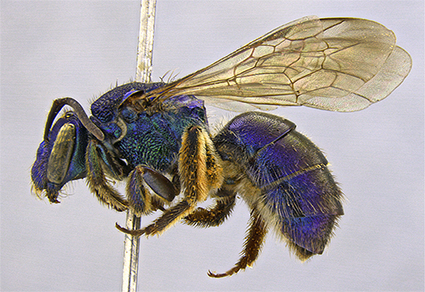Abstract
Augochloropsis (Glyptobasia) Moure, a small Neotropical subgenus, is revised, with the description of a new species, Augochloropsis aenea sp. nov., from Puno, southern Peru. Augochloropsis (Glyptobasia) comprised the two nominal species, A. bertonii (Schrottky) with a bluish-violet body coloration and A. chloera (Moure) with a bright green body coloration, both species have coarse integumental punctures and an unusual propodeal structure. We interpret these striking color differences, as a case of color polymorphism within a single species. Therefore, Moure’s taxon is placed as a junior synonym of A. bertonii. An identification key for the species and a distribution map are also provided.
References
- Aguiar, A.J.C. & Melo, G.A.R. (2011) Revision and phylogeny of the bee genus Paratetrapedia Moure, with description of a new genus from the Andean Cordillera (Hymenoptera, Apidae, Tapinotaspidini). Zoological Journal of the Linnean Society, 162, 351–442. https://doi.org/10.1111/j.1096-3642.2010.00678.x
- Brothers, D.J. (1976) Modifications of the metapostnotum and origin of the ‘propodeal triangle’ in Hymenoptera Aculeata. Systematic Entomology, 1, 177–182. https://doi.org/10.1111/j.1365-3113.1976.tb00036.x
- Celis, C.J. & Cure, J.R. (2017) Filogenia y clasificación taxonómica de los subgéneros de Augochloropsis (Hymenoptera: Halictidae). Revista de Biología Tropical, 65 (4), 1277–1306. https://doi.org/10.15517/rbt.v65i4.26549
- Celis, C.J. & Melo, G.A.R. (2022) Taxonomic revision of Augochloropsis (Glytochlora) Moure, a rare bee subgenus from the Amazon Basin (Hymenoptera: Halictinae). Zootaxa, 5182 (1), 21–40. https://doi.org/10.11646/zootaxa.5182.1.2
- Dallwitz, M.J. (1974) A flexible computer program for generating identification keys. Systematic Zoology, 23, 50–57. https://doi.org/10.2307/2412239
- Dallwitz, M.J. (1980) A general system for coding taxonomic descriptions. Taxon, 29, 41–46. https://doi.org/10.2307/1219595
- Dallwitz, M.J., Paine, T.A. & Zurcher, E.J. (2020a) User’s guide to the DELTA system: a general system for processing taxonomic descriptions, 1–129. Available from: delta-intkey.com (accessed 15 September 2021)
- Dallwitz, M.J., Paine, T.A. & Zurcher, E. (2020b) User’s guide to the DELTA Editor. 43 pp. Available from: https://www.delta-intkey.com/ (accessed 15 September 2021)
- Eickwort, G.C. (1969) A comparative morphological study and generic revision of the augochlorine bees (Hymenoptera: Halictidae). The University of Kansas Science Bulletin, 48 (13), 325–524. https://doi.org/10.5962/bhl.part.11227
- Engel, M.S. (2000) Classification of the bee tribe Augochlorini (Hymenoptera: Halictidae). Bulletin of the American Museum of Natural History, 250, 1–89. https://doi.org/10.1206/0003-0090(2000)250%3C0001:COTBTA%3E2.0.CO;2
- Garcete-Barrett, B.R. (1996) The collection of Arnaldo de Winkelried Bertoni. Sphecos, 30, 25–26.
- Gonçalves, R.B. (2017) Phylogeny and new species of the Neotropical bee genus Paroxystoglossa Moure (Hymenoptera, Apoidea). Revista Brasileira de Entomologia, 61, 178–191. https://doi.org/10.1016/j.rbe.2017.03.001
- Gonçalves, R.B. (2019) New species of Neocorynura Schrottky from Brazil (Hymenoptera: Apoidea). Zootaxa, 4542 (1), 1–132. https://doi.org/10.11646/zootaxa.4542.1.1
- Gonçalves, R.B. (2019) Phylogeny of the Augochlora clade with the description of four new species (Hymenoptera, Apoidea). Revista Brasileira de Entomologia, 63, 91–100. https://doi.org/10.1016/j.rbe.2018.12.003
- Gonçalves, R.B., Meira, O.M. & Rosa, B.B. (2022) Total-evidence dating and morphological partitioning: a novel approach to understand the phylogeny and biogeography of augochlorini bees (Hymenoptera: Apoidea). Zoological Journal of the Linnean Society, 20, 1–17. https://doi.org/10.1093/zoolinnean/zlab098
- González-Vaquero, R.A. & Roig-Alsina, A. (2017) Phylogeny of the Corynura group, an endemic southern South American clade sister to all other Augochlorini bees (Hymenoptera: Halictidae), and a revision of Corynura. Arthropod systematics & phylogeny, 75 (3), 435–479. https://doi.org/10.3897/asp.75.e31917
- Harris, R.A. (1979) Glossary of surface sculpturing. Occasional Papers in Entomology, 28, 1–31.
- Kjernsmo, K., Hall, J.R., Doyle, C., Khuzayim, N., Cuthill, I.C., Scott-Samuel, N.E. & Whitney, H.M. (2018) Iridescence impairs object recognition in bumblebees. Scientific Reports, 8 (8095), 1–5. https://doi.org/10.1038/s41598-018-26571-6
- Lepeco, A. & Gonçalves, R.B. (2018) The Colour and the Shape: Morphological Variation on a Facultatively Eusocial Bee Augochlora (Augochlora) amphitrite (Schrottky). Sociobiology, 65 (4), 662–670. https://doi.org/10.13102/sociobiology.v65i4.3388
- Melo, G.A.R., Faria, L.R.R. & Santos, L.M. (2019) Xenochlora meridionalis sp. nov. (Hymenoptera:Apidae), a new halictine bee from eastern Brazil as evidence of past connections between Amazonia and Atlantic Forest. Zoologia, 36, 1–7. https://doi.org/10.3897/zoologia.36.e33805
- Michener, C.D. (2007) The Bees of the world. 2nd Edition. The Johns Hopkins University Press, Baltimore, Maryland, 953 pp.
- Moure, J.S. (1940) I – Apoidea Neotropica. Arquivos de Zoologia, 2, 39–64. https://doi.org/10.11606/issn.2176-7793.1941239-64
- Moure, J.S. (1941) Apoidea neotropical–III. Arquivos do Museu Paranaense, 1, 41–99.
- Moure, J.S. (1943) Notas sôbre abelhas da coleção Zikán (Hym. Apoidea). Revista de Entomologia, 14 (3), 447–484.
- Moure, J.S. (1958) On the species of Megalopta described by F. Smith (Hymenoptera, Apoidea). Journal of the New York Entomological Society, 66, 179–190.
- Moure, J.S. (2007) Augochlorini Beebe, 1925. In: Moure, J.S., Urban, D. & Melo, G.A.R. (Orgs.), Catalogue of Bees (Hymenoptera, Apoidea) in the Neotropical Region. Sociedade Brasileira de Entomologia. Curitiba, Paraná, pp. 1–1058.
- Moure, J.S. & Hurd, P.D. (1987) Anannotated catalog of the halictid bees of the Western Hemisphere (Hymenoptera: Halictidae). Smithsonian Institution Press, Washington, 405 pp.
- Pereboom, J.J.M. & Biesmeijer, J.C. (2003) Thermal constraints for stingless bee foragers: the importance of body size and colouration. Oecologia, 137, 42–50. https://doi.org/10.1007/s00442-003-1324-2
- Prates, I., Melo-Sampaio, P.R., Oliveira Frummond, L., Texeira Jr, M., Rodrigues, M.T. & Carnaval, A.C. (2017) Biogeographic links between Southern Atlantic Forest western South America: Rediscovery, re-description, and phylogenetic relationships of two rare montane anole lizards from Brazil. Molecular Phylogenetics and Evolution, 113, 49–58. https://doi.org/10.1016/j.ympev.2017.05.009
- Rasmussen, C., Garcete-Barrett, B.R. & Gonçalves, R.B. (2009) Curt Schrottky (1874–1937): South American entomology at the beginning of the 20th century (Hymenoptera, Lepidoptera, Diptera. Zootaxa, 2282 (1), 1–50. https://doi.org/10.11646/zootaxa.2282.1.1
- Santos, L.M. (2014) Análise cladística das abelhas do gênero Augochloropsis Cockerell, 1897 (Hymenoptera: Apidae s. l.: Augochlorini). PhD dissertation. Universidade Federal do Paraná, Curitiba. [unknown pagination]
- Schrottky, C. (1909) Nuevos himenópteros sudamericanos. Revista del Museo de La Plata, 16 (3), 137–149.
- Smith-Pardo, A.H. (2010) Taxonomic review of the species of Neocorynura (Hymenoptera: Halictidae: Augochlorini) inhabiting Argentina and Paraguay. Zootaxa, 2507 (1), 44–68. https://doi.org/10.11646/zootaxa.2507.1.3
- Trujillo-Arias, N., Calderón, L., Santos, F.R., Miyaki, C.Y., Aleixo, A., Witt, C.C., Tubaro, P.L. & Cabanne, G.S. (2018) Forest corridors between the central Andes and the southern Atlantic Forest enabled dispersal and peripatric diversification without niche divergence in a passerine. Molecular Phylogenetics and Evolution, 128, 221–232. https://doi.org/10.1016/j.ympev.2018.08.005


